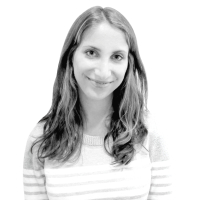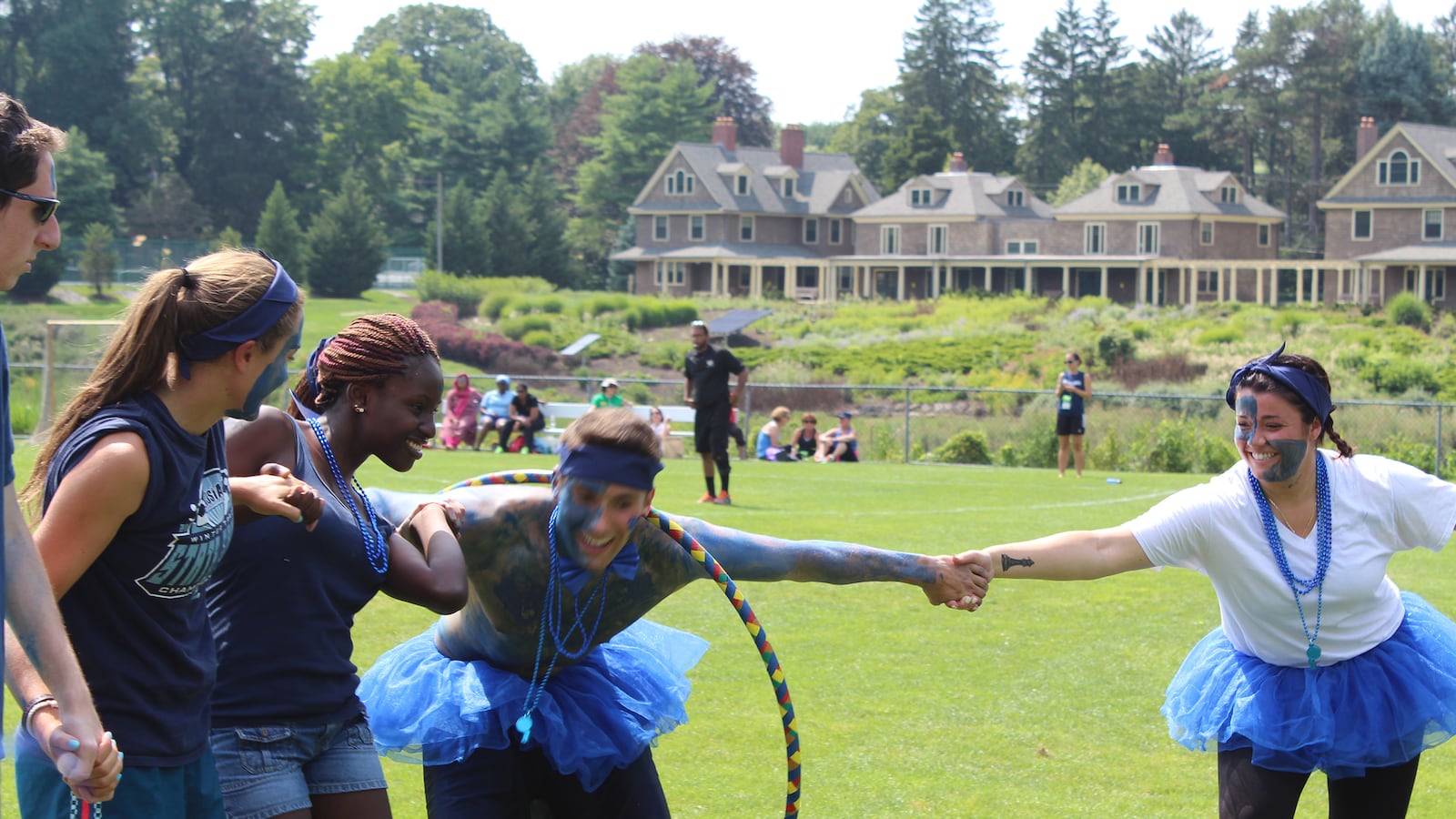It could be a scene from any summer camp: a group of teens paints each others’ faces and puts the final flourishes on signs, while clapping along to battle chants against the idyllic backdrop of a leafy campus courtyard. Badges hanging from their necks boast small national flags, and a cacophony of accents represents more than 20 countries.
Like other camps, friendships at Project Common Bond spark fast and strong. But here that connection stems from a deeper, darker place. Each camper, between 15 and 20 years old, is in attendance because he or she has lost a family member to terrorism. They’ve had parents killed in 9/11, uncles and cousins murdered on both sides of the Israel-Palestine conflict, and experienced firsthand the violence in Northern Ireland.
But for one week each summer, they leave their often-turbulent homelands behind and come together to discuss the far-flung conflicts that have touched each of them so personally. Together, they reveal their histories, teaching and learning from the shared tragedies of the past.
Some of the attendees have stories that are yet unfinished, and a week away can be stressful for those flying in from countries currently plastered on the news. This year, in particular, some of the kids have stayed glued to their phones as fighting rages across the Middle East, checking in on family members thousands of miles away.
The camp, now in its seventh year, is the offshoot of an organization called Tuesday’s Children, which sprouted a few months after Sept. 11 to unite the children of the terror attack’s victims. Now, as the original campers age out of attendance, the camp has widened its mission, offering spots to participants from all corners of the Earth who are chosen by recommendations from youth organizations and embassies.
On a Sunday in late July, the campers of Project Common Bond gather beneath an archway on the medieval-esque campus of Bryn Mawr outside Philadelphia, forming a mass of green, blue, orange, and red. Despite the battle cries, war paint, and sassy taunts, this isn’t a violent rally; they’re prepping for the “Peace Games,” an Olympics of good, old-fashioned camp activities.
This year, the week is especially tough for kids coming from both side of the Israel/Palestine conflict. Just a few days before they arrived at camp, Israel launched a ground operation in Gaza and the death toll climbed to 340. As the week played out, casualties tripled. For the Israeli and Palestinian campers, being in a comfortable Pennsylvania suburb was often a guilt-inducing respite from the escalating conflict their families were facing at home.
Draped in a light-blue bib and conical hat to represent his team, Isaac Othmen has been coming to the camp for three years. The 20-year-old Palestinian lives in the West Bank and studies public health and nutrition as a college sophomore. “The war in Gaza now is insane…I’m really worried,” he says. He fears, especially, the volatility of it all: the checkpoints, the nearby Israeli settlements, and the bombings. “It’s really hard to predict the next move, so I might die in any small instance,” he says. “I’m really worried about my family…I don’t want to lose someone while I’m here having fun and sharing my story.”
Othmen was surprised to find attendees from across Africa and Northern Ireland who had similar stories of their own childhoods; he had always thought that his problems living in an occupied territory were unique.
He’s even began to communicate with an Israeli camper, a 15-year-old named Tomar Avisar, after realizing that they were both at the camp to seek peace. “If we talk, I give him my point of view, my story that he can’t see on the news or media…and let him decide for himself what’s wrong or right,” Othmen says. “I hope not to cause more problems—not to cause more people to kill.”
Avisar, who sports a green handkerchief and a face streaked with green paint, is from the city of Holon, near Tel Aviv. In three years he’ll have to begin his mandatory army service, a role he feels conflicted about: It’s his patriotic duty, but it’s not representative of his wish for peace.
There have been arguments between campers with conflicting viewpoints in the past, camp leaders say, but these disagreements are prime for use as a teaching lesson within small groups. But this year, when it comes to the Israeli and Palestinian campers, there has been nothing but respect between the campers, according to Avisar, even as their two countries are increasingly pit against each other.
“[The Palestinians are] really nice people…I thought there would be more anger at me,” Avisar says. “I came here like I don’t know how the Palestinians and Algerians would react to me, I thought at least one kid would be angry at me, but no—it’s good.”
He regrets not getting to know the Palestinian attendees better, saying there’s no hatred, just a fundamental difficulty in discussing the conflict. “It’s hard to talk with them,” he says. “I’m really open about it, but still there’s a difference and it’s hard sometimes.” There were no Palestinians in his small discussion group (“Sadly,” he says), but Avisar assures they were represented at the camp.
“It’s not fair to tell only your side of the story,” Avisar says. “We’re not all the same—some people from our side think all of them want to kill us. No, it’s nothing like that. I’m trying to bring the idea of peace by looking [at] both sides of the story, and by accepting each other.”
Each day begins with a small two-hour discussion session, called “Dignity Group,” where attendees from a diverse smattering of countries and conflicts gather to share their stories. Afterwards, in the afternoon, campers pick between theater, dance, athletics, and crafts. “Trauma gets you stuck,” drama teacher Maria Hodermarska says, but “if you can play with something you’re free.” At night there are dance parties and lectures and activities.
Project Common Bond sees these kids as the people who can put a plug in the animosity that led to their loved ones’ deaths, and effectively stop an otherwise cyclical response of violence. In a dignity group discussion, curriculum leader Monica Meehan-McNamara is amazed by a girl who shares her story of watching her father and cousin killed in Saudi Arabia and then testifying at the murderers’ trial. “She said, ‘I’ve let go of my anger because I look at them and I think: they were children once, they didn’t start out this way—what is it that led them to this point?’”
Meehan-McNamara says she’s often watched campers affected by 9/11 reach across to Muslim attendees and admit they had blamed the religion for the attacks, but now see the fault in their views.
“When I read about these places that experience conflicts I really have a better understanding of it, because I now have firsthand accounts,” Casey Hargrave, a 19-year-old George Washington University student, says. Decked out in green, with an emerald boa draped around her neck, Hargrave says she lost her father in the World Trade Center attacks on Sept. 11. “I can read it and hear those people talk about it in my head, and I can begin to almost understand where they’re coming from and how they want to change their country.”
At camp, the attendees find, as the name suggests, a common ground to share a part of their own personal histories and empathize with those of others. “Here you don’t have to worry about it because they all know,” Hargrave says of her family’s tragedy. “You can talk about anything you want and know they’ve all been through the same thing.”
On a green field below the sloping campus, teams huddle and plot strategy as group leaders and refs get the games into place. To the chants of competing colors (“We’re better than the rest—Go green!” “Who’s hot? Red’s hot!”) and a mashup of war songs (“We’re not gonna take it” is shouted over “Eye of the tiger”), the teens wrap each other in toilet paper, run back-to-back without popping a balloon, and balance socks on clothing hangers.
When the week ends, the participants are already connected for life through a whole medley of social media—they list off Facebook, Twitter, Gchat, Snapchat. But camp leaders hope the influence of who the campers have met and what they’ve learned reaches far past the small group of fast friendships, infiltrating each participant’s family, school, and neighborhood.






